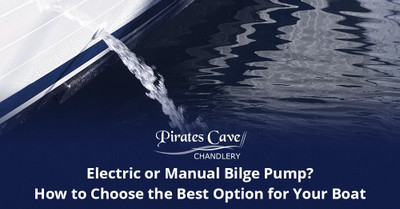18th Sep 2025
When it comes to keeping your boat safe and dry, few pieces of equipment are as important as the bilge pump. A reliable bilge pump can mean the difference between a minor inconvenience and a dangerous situation on the water. But one question we hear a lot from boaters is: Should I rely on an electric bilge pump, a manual one, or both?
In this guide, we’ll break down the differences between electric and manual bilge pumps, explore their pros and cons, and help you decide which option (or combination) makes the most sense for your boat.
Why Bilge Pumps Matter
The bilge is the lowest part of your boat, where water naturally collects. Rainwater, waves, leaks in fittings, or even condensation can find their way into the bilge. Without a way to remove it, that water builds up - potentially flooding the boat, damaging electrical systems, or even compromising buoyancy.
A good bilge pump setup isn’t just a convenience - it’s a vital safety feature.
Electric Bilge Pumps
Electric pumps are the most common choice for today’s boat owners. They’re powered by your boat’s battery and usually installed permanently in the bilge with a float switch or electronic sensor.
Pros of Electric Bilge Pumps:
- Hands-free operation - Automatic models start pumping the moment water reaches a set level.
- High capacity - They can move a lot of water quickly, measured in gallons per hour (GPH) or litres per hour (LPH).
- Convenient - No need to crank or pump manually; you can focus on steering and handling emergencies.
- Compact and affordable - A wide range of models are available for most boat sizes.
Cons of Electric Bilge Pumps:
- Battery dependent - If your marine battery is flat or the electrical system fails, the pump won’t work.
- Can clog – Debris in the bilge may block the pump or float switch.
- Maintenance required - Wiring, fuses, and switches need to be checked regularly.
- Not foolproof - Even the best automatic bilge pumps can fail without notice if not tested.
Manual Bilge Pumps
Manual pumps don’t rely on power. They use a lever, diaphragm, or handle that you operate by hand. Some are fixed to the boat, while others are portable.
Pros of Manual Bilge Pumps:
- Always available – No battery or wiring required.
- Reliable in emergencies – If your electrics fail, a manual pump will still work.
- Simple and durable – Fewer moving parts mean fewer things to go wrong.
- Useful for smaller boats – Inflatable dinghies, tenders, and kayaks often rely on manual bilge pumps.
Cons of Manual Bilge Pumps
- Labour intensive – You (or your crew) must operate it, which is tiring during heavy flooding.
- Lower capacity – They generally can’t match the flow rate of a large electric pump.
- Crew dependent – If you’re alone or incapacitated, the pump won’t be of much use.
- Storage and access – Portable versions need to be stowed somewhere handy, or they won’t help in time.
Which Should You Choose?
The short answer: both.
For most boats, the best setup is a combination:
Primary system: One or more electric bilge pumps for everyday peace of mind.
Backup system: At least one manual pump in case of electrical failure or catastrophic flooding.
This redundancy ensures you’re covered whether you’re dealing with a trickle of rainwater or a sudden leak offshore.
Recommendations by Boat Type
Small dinghies, tenders, kayaks – A portable manual pump or even a simple bailer may be enough.
Day boats & trailer boats – A single electric pump backed up by a manual unit is ideal.
Cruisers & offshore yachts – Multiple electric pumps (with separate circuits) plus at least one fixed manual pump accessible from the cockpit.
Motorboats – Large-capacity electric pumps as standard, with manual backup in case of system failure.
Maintenance Tips
Test regularly – Run your electric pump and check float switches before every trip.
Inspect hoses & wiring – Make sure there are no cracks, corrosion, or loose connections.
Keep bilges clean – Remove debris and oil to prevent clogs.
Service manuals – Check diaphragms, seals, and handles periodically.
Final Thoughts
When it comes to bilge pumps, redundancy is safety. Electric pumps handle the heavy lifting, but manual pumps are a critical backup when the unexpected happens. Investing in both, and keeping them well maintained means you’re ready for whatever the water throws at you.
If you're still not sure which bilge pump is most suited to your requirements, don't stress - our highly experienced team are here to help, contact us today or visit our Rochester store!



